Having left behind our Supreme Directors with the short-lived 4 day and some hour tenure of Julian Aguirre, the government of Argentina, as a setup of various coalitions, was dissolved. I have to admit to being unclear as to how the country was run for the next six years, and the gap is noticeable in various histories of the country, most talking more about the Argentine-Brazilian War that occupied that period and took until the late 1820s to resolve, with the mediation of the the UK and France. But, it was not until February 8, 1826, 8 days short of 6 years on, that Argentina’s first president was elected, Bernardino de la Trinidad Gónzalez Rivadavia y Rivadavia.
Rivadavia had been active in the anti-British resistance, and then later was an envoy to both Britain and Spain. He was appointed as a government minister, and under his direction many projects to improve the image of Buenos Aires, literally, were undertaken, often at the expense of the rest of the country – major avenues, paving, street lighting, schools – including the founding of the University of Buenos Aires, the natural science museum, and various academies. He arranged for some of the first public bonds to be issued – sold in London – to finance major public works across the province – few of which ever came to light, and the debt was transferred to the nation just prior to his becoming president – a debt that took the country another 80 years to pay off. He was married to the daughter of the Spanish Viceroy of the region. His presidency was plagued by problems, including the ongoing war with Brazil over the territory that eventually became Uruguay, and a growing federalist sentiment – Rivadavia was a centralist and felt that all governmental power should have emanated from Buenos Aires. His presidency was short-lived, he resigned on June 29, 1827, 1 year and 4 months after assuming the office.
As befitting, perhaps, someone who undertook the construction and pavement of the major avenues of the city, and province, the thoroughfare that bears his name, Avenida Rivadavia, is pretty impressive. It is not, as Argentines like to think, the longest street in the world – one could vaguely make the claim that within city limits, perhaps, though even that is doubtful, it only racks up a bit under 12 kilometers (7.5 miles), though continues into the suburbs of Greater Buenos Aires and tops out around 30 kilometers (16.6 miles). Technically, the first section of it, from the Plaza de Mayo to the Plaza Congreso, is Calle Rivadavia, and it doesn’t become an avenue until after Congreso, but few make that distinction. The street was originally built in 1782 and was known as Calle de las Torres (Street of the Towers) or sometimes Calle de Los Reynos Del Arriba (Street of the Kingdoms Above) and later the center of town part was known as Calle Plata (Silver Street) while the extension was called Camino Real del Oeste (Royal Way of the West), which actually extended, and extends to the city of Luján in the province of Mendoza – and this is where the idea that it is the longest street comes from, though it’s still shorter than both Yonge Street in Canada. It changed names more times, and was first called Rivadavia in 1857. It also has the distinction, one supposes, of being the route of the first bus line in Argentina, which ran along it from Primera Junta to Lacarra.
I’m not sure how I’m going to divide up those 12 kilometers – possibly, simply, by points of interest, which may mean shorter sections during the early part of the walks, though, we shall see. I should note, the avenue is known as “the spine of Buenos Aires”, hence the post title, because it is the zero-point for all the north-south streets that cross it – they change name and being counting from zero in opposite directions.
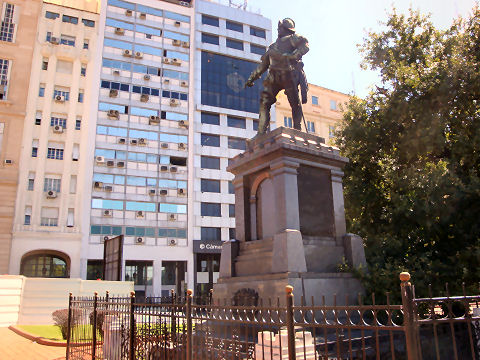
The street starts in a small park alongside Av. Alem, at basically the 200 mark. There’s little of interest, a parking lot for commuters… it really begins, for our purposes, in a small plaza with a statue of 16th century Basque explorer and conquistador, Juan de Garay, most noted here in Argentina for being the second founder of the city. He might be better known amongst the historians of the explorer community, for his fruitless search for the legendary City of the Caesars, a mythical place of gold, silver and diamonds, thought to be somewhere in Patagonia along the border with Chile. The bronze statue was commissioned in 1915 and installed in 1919.
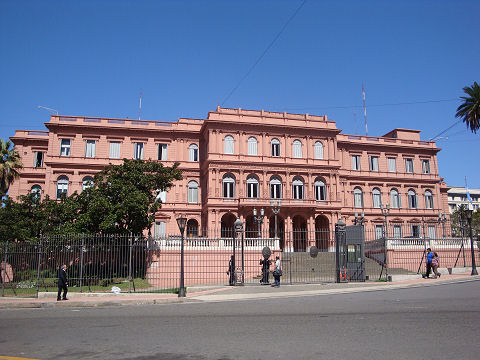
Across from the statue, to our left, is the side entrance to the Casa Rosada, addressed on the cross street of Balcarce. From there, we immediately find ourselves in the Plaza de Mayo, originally the Plaza Mayor, or town square.
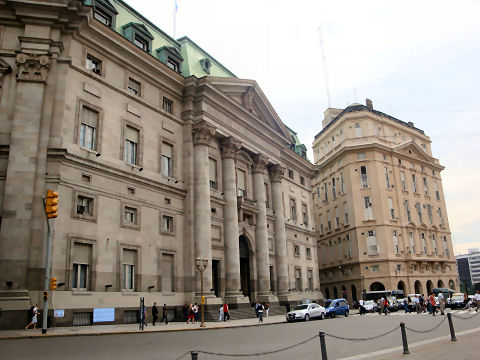
Stepping across and into the plaza gives us a better view of the buildings along Rivadavia. Of most interest, immediately across from the Casa Rosada, are these two. The smaller, wedge-shaped and slightly nondescript building is not well known. It is the home of SIDE, the Secretaría de Inteligencia del Estado, a combined secret police and spy agency all in one. Next to it is now the local headquarters for Banco Francés, but originally this was built as the Nuevo Banco Italiano in 1933. In the main entry foyer are bronze statues of the bank’s founders.
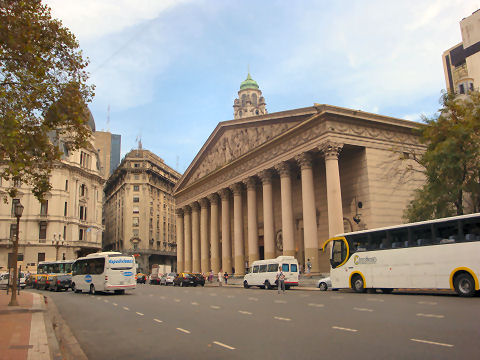
Looking the other way, along the direction of our walk, is the Catedral Metropolitano, which I could have sworn I’d written about way back, but I don’t find it in my search, so I may have to go back, dig out my photos, and writeup another entry. Not looking like “a typical” cathedral, at least not so ornate on the outside, it’s pretty impressive inside, and includes the mausoleum for the remains of “the great liberator”, General San Martín, along with an eternal flame outside… more on all that one of these days soon.
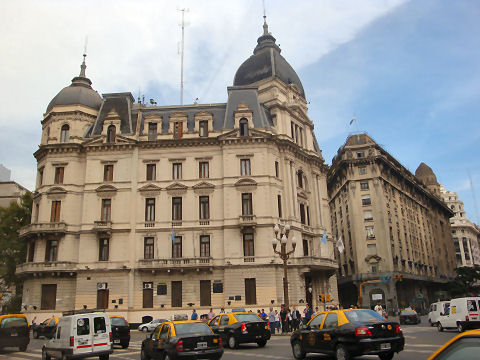
To the left is the Palacio de Gobierno, the home of the city’s government, originally the Palacio Municipal de la Ciudad de Buenos Aries, built in 1902 in a French Academic style. There are always a couple of soldiers guarding the main entrance, reminiscent of British Beefeaters, palace guard sorts, but without the stoic nature.
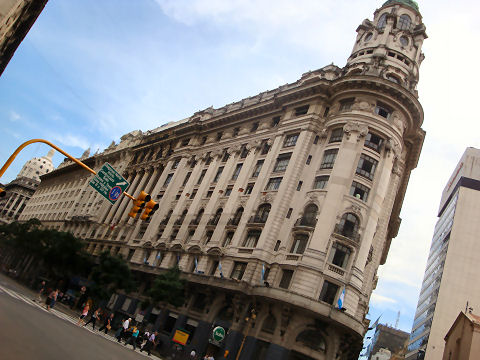
Looking to the right, not on Rivadavia, but imposing alongside the Metropolitan Cathedral, is the Edificio Banco Argentino Uruguayo, a 1928 construction that today houses the ministries of the various federal cabinet members.
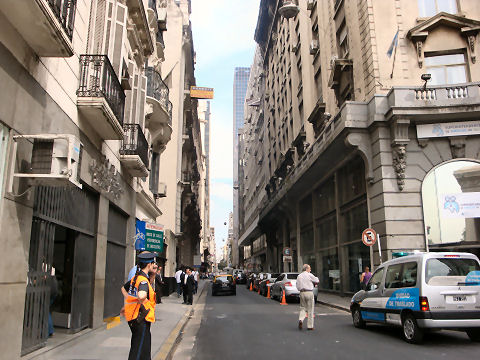
Leaving the plaza behind, we enter Calle Rivadavia proper, which, with one side parking, narrows to a single lane and continues this way until we reach, much further on, the Plaza Congreso. It does make taking well-angled photos a bit of a chore… as you’ll see.
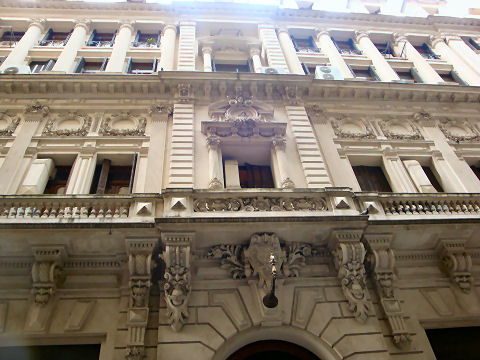
The left hand side is primarily dominated by the back entrances to many important buildings along the parallel Av. de Mayo. The right hand side is a mix of office buildings and residences. I can’t say that there are a huge number of standout buildings of historic interest (at least as far as I know), but it is an interesting walk, architecturally speaking. This is the rear of the La Prensa building, immediately adjacent to the above Palacio, originally the headquarters of the city’s most powerful newspaper organization, now taken over by the city for the Casa de Cultura, a major source of tourism information – there are tours available of the building… something else for a future post.
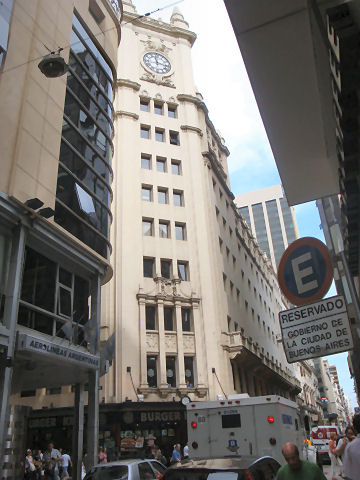
Of interest to many visitors, though I recommend against it other than as an interesting walk (for the most part, overpriced ripoffs), we approach the pedestrian shopping street of Calle Florida and Calle Peru. To the left, the Casa Escasany, built in 1892 to house a jewelry firm. Today it houses a fast food restaurant on the ground floor and the offices of EnTel above.
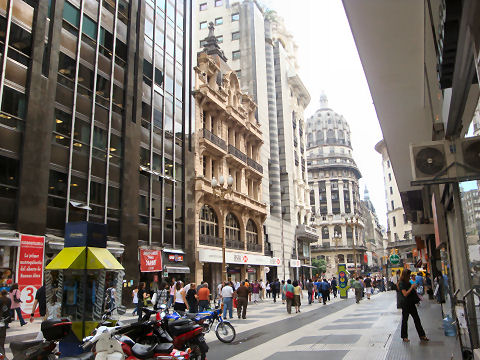
Looking to the right is Calle Florida…
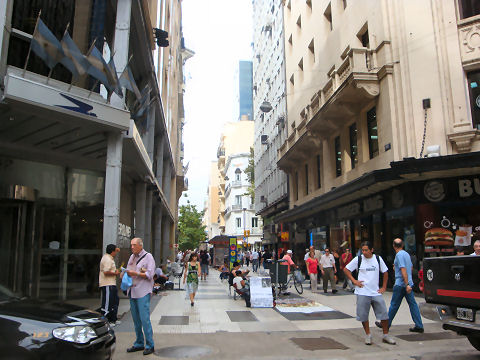
…and to the left, Calle Perú, which continues only a short distance as a shopping area and then becomes primarily a residential street running into Monserrat and San Telmo.
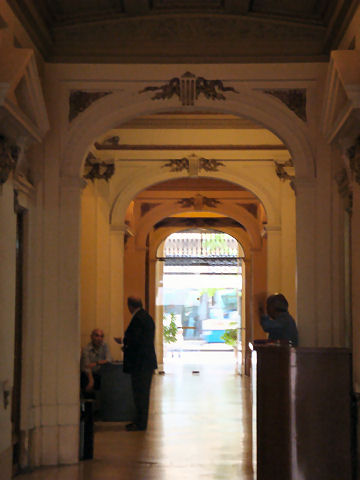
In the 700 block is the pretty little passageway through to Av. de Mayo, Pasaje Urquiza Anchorena, passing under the office building of the same name, built in 1921 as an office building for a medical insurance company.
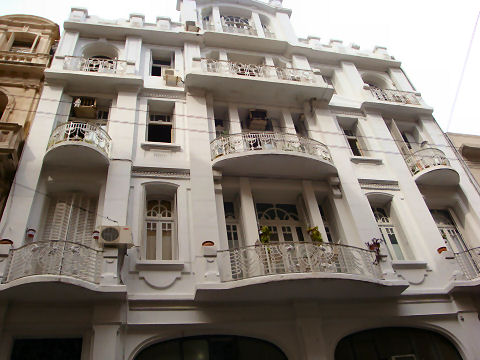
I’m sure this was/is a building of note, I just thought it was interesting architecturally. The engraving above the door dates it to 1897. I think, though I’m not certain, that this was originally the Ortiz Basualdo residence. [Edit: Confirmed that this was that residence, though I don’t know any details about its history beyond that.]
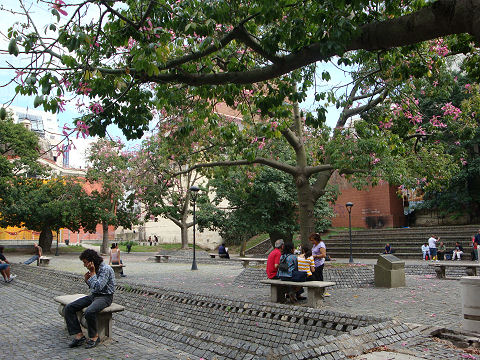
At the corner of Calle Esmeralda there is a small and quite beautiful plaza dedicated to author Roberto Arlt, who was known primarily for his regular columns between 1928 and 1943 in the newspaper El Mundo, commenting on the peculiarities and oddities of daily life and institutions in Argentina. The plaza is noted for its flowering trees.
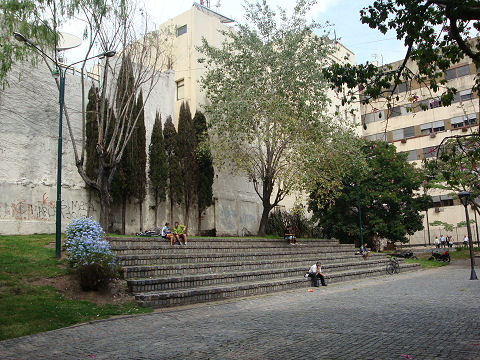
More of the plaza…
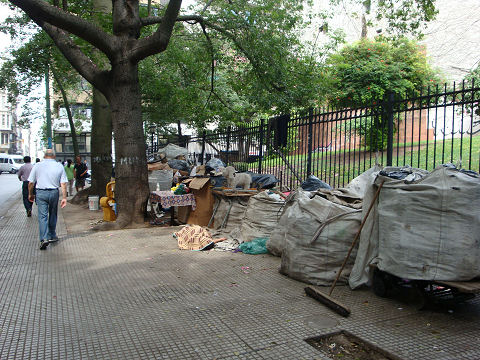
In the last year or so, on the sidewalk outside of the plaza, has sprung up a little tent city of sorts where cartoneros gather, often to sleep. It is surprising, given the city’s push to “clean up” its image, that this continues in the midst of a main commercial district.
This seems as good a spot to pause as any in the walk. I’ll continue next time from here on to at least Plaza Congreso.
Great photos! Please continue. Soon I’ll be working with students living and studying near Carabobo and Rivadavia. You have a few miles to go….
[…] up where I left off along my Av. Rivadavia wander back at Suipacha and Plaza Arlt… our next segment runs from […]
[…] was part of the Unitarian faction, the party of Bernardino Rivadavia (whose eponymous avenue took eight posts to cover the 11.5km). By executing Dorrego, he installed […]